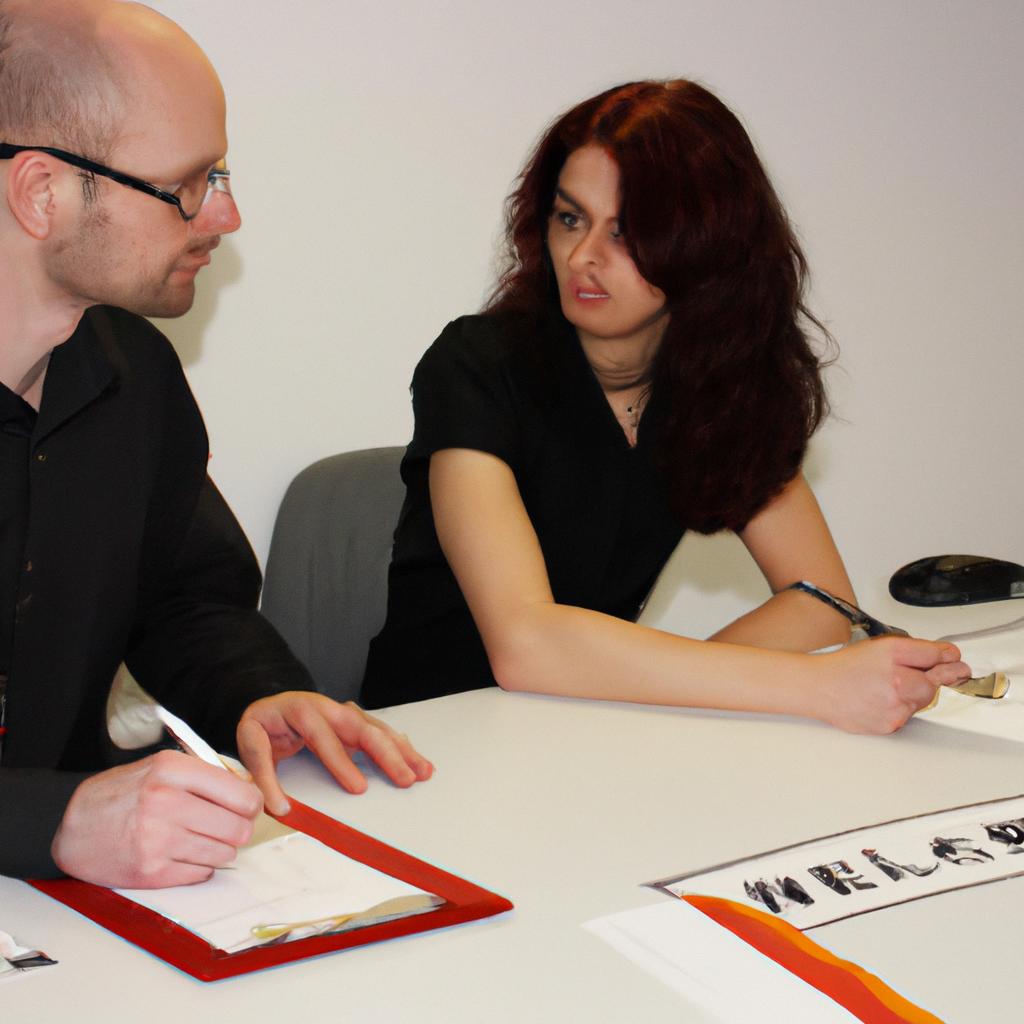Disfigurement and Relief: Pain and Suffering Damages
In the realm of personal injury law, one aspect that plays a crucial role in determining damages is disfigurement. Disfigurement refers to any permanent alteration or deformity of a person’s physical appearance as a result of an accident or intentional harm caused by another party. The impact of such disfiguring injuries can be profound, leading to emotional distress, loss of self-esteem, and social isolation for the affected individual. For instance, consider the case of Jane Doe, who suffered severe facial scarring due to a car accident caused by reckless driving. This hypothetical scenario highlights the significance of addressing pain and suffering damages associated with disfigurement cases.
The assessment and quantification of pain and suffering damages related to disfigurement are complex tasks within legal proceedings. Courts aim to compensate victims adequately for their physical and emotional anguish resulting from these life-altering injuries while maintaining fairness and consistency in awarding damages. Particularly challenging is assigning monetary value to non-economic losses like mental anguish, humiliation, embarrassment, and decreased quality of life experienced by individuals whose appearances have been permanently altered. Understanding the factors involved in evaluating pain and suffering damages becomes imperative for both plaintiffs seeking compensation and defendants aiming to defend against such claims.
When determining pain and suffering damages in disfigurement cases, several factors are taken into consideration. These factors may include the severity and permanence of the disfigurement, the age and gender of the victim, the impact on their daily life and relationships, psychological effects such as depression or anxiety, medical treatments required for rehabilitation or cosmetic procedures, and any future implications that may arise due to the disfigurement.
Courts typically rely on expert testimony from medical professionals, psychologists, and other relevant specialists to assess these factors. They consider how the disfigurement affects the individual’s overall well-being and quality of life. Additionally, they may take into account similar cases with comparable injuries to establish a precedent for compensation amounts.
It is important to note that pain and suffering damages are subjective in nature. There is no fixed formula or standard calculation used across all jurisdictions. Instead, courts exercise discretion based on the specific circumstances of each case. This means that awards can vary significantly depending on various factors unique to each situation.
To present a strong claim for pain and suffering damages in a disfigurement case, it is crucial to gather comprehensive evidence. This may include medical records documenting the extent of the injury and its impact on physical health, photographs or videos showing visible changes in appearance, testimonies from mental health professionals regarding emotional distress suffered by the victim, witness statements attesting to changes in social interactions or relationships since the injury occurred, and documentation of any past or future expenses related to treatments or therapies aimed at improving appearance or coping with psychological trauma.
In summary, addressing pain and suffering damages associated with disfigurement requires careful evaluation of multiple factors specific to each case. Seeking legal advice from an experienced personal injury attorney can be invaluable in navigating this complex area of law and ensuring fair compensation for victims who have endured both physical and emotional hardships due to their altered appearance.
Understanding Disfigurement Claims
Disfigurement is a significant aspect of personal injury cases, often leading to pain and suffering damages. To comprehend the intricacies of disfigurement claims, it is crucial to explore the definition, legal principles governing such claims, and the factors considered by courts in determining compensation.
An illustrative example can illuminate the impact of disfigurement on an individual’s life. Consider a hypothetical case involving Jane, who suffered severe burns on her face due to a workplace accident. As a result, she experienced emotional distress, social isolation, and anxiety about her appearance. These consequences highlight the profound psychological effects that disfigurement can have on an individual’s well-being.
To further emphasize the emotional toll of disfigurement, consider these bullet points:
- Individuals with visible scars may experience feelings of self-consciousness and shame.
- Social interactions may become challenging as others may react negatively or stare at their disfigured features.
- The stigma associated with physical differences could lead to decreased self-esteem and mental health issues.
- Engaging in activities they once enjoyed might be hindered due to fear of judgment or discrimination.
This three-column table demonstrates some specific challenges faced by individuals with disfigurements:
| Challenges | Emotional Impact | Daily Life Implications |
|---|---|---|
| Self-image concerns | Anxiety and depression | Difficulties in finding employment |
| Negative public perceptions | Low self-esteem | Limited access to healthcare services |
| Difficulty forming relationships | Isolation and loneliness | Reduced participation in social events |
| Stigmatization | Higher risk of mental health disorders | Barriers to educational opportunities |
Understanding the multifaceted impact of disfigurement allows for a more comprehensive evaluation when seeking pain and suffering damages. By considering both the emotional ramifications highlighted above and other relevant aspects like medical expenses or loss of income potential, courts endeavor to provide fair compensation based on each unique situation.
Transitioning smoothly into the subsequent section, it is essential to recognize that disfigurement profoundly affects an individual’s quality of life. By exploring its repercussions on various aspects such as self-esteem, relationships, and daily activities, we can develop a deeper comprehension of the true consequences faced by those living with disfiguring injuries.
The Impact of Disfigurement on Quality of Life
Understanding Disfigurement Claims can shed light on the numerous challenges faced by individuals who have suffered from disfiguring injuries. These claims aim to compensate victims for the physical, emotional, and psychological pain caused by these injuries. To further comprehend the impact of disfigurement on quality of life, it is crucial to explore how such injuries affect various aspects of a person’s well-being.
Consider the case of Sarah, a 28-year-old woman who was involved in a car accident resulting in severe burns across her face and body. Prior to the incident, Sarah had been an outgoing and confident individual. However, following the disfigurement she experienced, she found herself grappling with feelings of self-consciousness and social isolation. The scars left behind not only altered her appearance but also affected her mental health, making daily interactions challenging.
The emotional toll of disfigurement cannot be underestimated. It often leads to anxiety, depression, and low self-esteem among those affected. This has significant repercussions on their overall quality of life. Some key factors that contribute to this negative impact include:
- Stigmatization: Society tends to place undue emphasis on physical appearance, leading to discrimination against individuals with visible differences.
- Social withdrawal: Fear of judgment or rejection may cause people with disfigurements to withdraw from social activities and isolate themselves.
- Body image dissatisfaction: Disfiguring injuries can result in distorted perceptions of one’s own body image which affects self-confidence.
- Psychological distress: Coping with the trauma associated with disfigurement can lead to increased stress levels and decreased psychological well-being.
To illustrate these points vividly, consider the following table depicting some common challenges faced by individuals living with disfigurements:
| Challenges Faced by Individuals Living with Disfigurements |
|---|
| Stigmatization |
| – Discrimination based on appearance |
| – Prejudice and stereotypes |
| Social Withdrawal |
| – Avoidance of social situations |
| – Isolation from friends and family |
| Body Image Dissatisfaction |
| – Negative perception of oneself |
| – Discomfort with one’s own appearance |
| Psychological Distress |
| – Anxiety and depression |
| – Emotional instability |
Understanding the profound impact disfigurement has on an individual’s life is essential when considering pain and suffering damages. By recognizing these challenges, legal systems can better address the unique needs of individuals seeking compensation for their losses.
Transitioning into the subsequent section about “Proving the Severity of Disfigurement,” it becomes evident that navigating through this process requires a comprehensive understanding of how to establish and evaluate such claims effectively.
Proving the Severity of Disfigurement
Impact of Disfigurement on Quality of Life
Disfigurement can have a profound impact on an individual’s quality of life, affecting their physical and emotional well-being. To illustrate the severity of this impact, consider the hypothetical case of Sarah, a 35-year-old woman who sustained disfiguring facial burns in a car accident. As a result, she experienced significant psychological distress, social isolation, and decreased self-esteem.
Firstly, disfigurement often leads to psychological distress as individuals struggle with accepting their altered appearance. In Sarah’s case, her burns caused anxiety and depression due to feelings of self-consciousness and shame. She found it challenging to interact with others in public settings or engage in activities that previously brought her joy. This highlights how disfigurement can profoundly affect one’s mental health and overall happiness.
Secondly, disfigurement may lead to social isolation as individuals feel stigmatized by society. People with visible differences often face prejudice and discrimination, which can further exacerbate their emotional struggles. Sarah experienced instances where strangers would stare or make hurtful comments about her appearance in public places. Such experiences contributed to feelings of loneliness and alienation from society.
Lastly, disfigurement can significantly undermine an individual’s self-esteem and confidence levels. The constant reminder of their altered appearance makes it difficult for them to maintain positive body image perception. Sarah found herself avoiding mirrors or photographs out of fear that confronting her reflection might worsen her already fragile sense of self-worth.
The emotional toll caused by severe disfigurements is undeniable. To emphasize this point further, let us look at some key emotions experienced by many individuals facing such challenges:
- Anguish: Feelings of deep suffering and distress.
- Shame: A strong sense of embarrassment or humiliation.
- Isolation: A state of being alone or cut off from others.
- Despair: An overwhelming feeling of hopelessness or sadness.
Additionally, we can examine the psychological impact of disfigurement through a comparative table:
| Psychological Impact | Description |
|---|---|
| Anxiety | Experiencing intense worry or fear in various situations. |
| Depression | Persistent feelings of sadness, hopelessness, and loss of interest. |
| Low self-esteem | A negative perception of one’s own worth and value. |
| Post-traumatic stress | Recurring distressing memories, flashbacks, or nightmares. |
By highlighting these emotions and providing a visual representation of their psychological impact, we aim to evoke empathy from our audience towards individuals who endure such hardships.
Understanding the profound effects that disfigurement has on an individual’s quality of life is crucial when considering pain and suffering damages in legal cases. In the subsequent section about “Factors Considered in Calculating Damages,” we will explore how courts assess the extent of these damages and provide appropriate compensation for the physical and emotional toll experienced by victims.
Factors Considered in Calculating Damages
Building upon the previous section’s exploration of proving the severity of disfigurement, this section delves into the factors considered in calculating pain and suffering damages. To better understand how these damages are determined, let us first examine a hypothetical case study:
Case Study:
Imagine an individual named Sarah who sustained severe facial burns due to a workplace accident. These burns left her with permanent scars that significantly altered her appearance. As a result, Sarah experiences emotional distress, anxiety, and feelings of social isolation.
Factors Considered in Calculating Damages:
- Nature and Extent of Disfigurement: The severity and permanency of the disfigurement play a crucial role in determining pain and suffering damages. More substantial physical alterations resulting from disfigurement often lead to higher compensation amounts.
- Psychological Impact: Emotional distress caused by disfigurement is another critical aspect taken into account when assessing damages. This includes psychological consequences such as depression, anxiety disorders, post-traumatic stress disorder (PTSD), or any other mental health conditions arising from the visible changes.
- Social Consequences: Disfigurement can have far-reaching effects on an individual’s personal relationships and societal interactions. Factors like diminished self-esteem, loss of confidence in public settings, discrimination, or stigmatization contribute to evaluating the overall impact on one’s quality of life.
- Age and Gender: In certain cases, age and gender may influence the evaluation process for pain and suffering damages related to disfigurement. For instance, young children or individuals whose jobs heavily rely on their physical appearance may be granted higher compensation due to potential long-term implications.
- Fear
- Anguish
- Isolation
- Shame
Table – Emotional Consequences Associated with Disfigurement:
| Emotion | Description |
|---|---|
| Fear | Overwhelming sense of dread or unease |
| Anguish | Intense suffering or distress |
| Isolation | Feeling socially disconnected or alone |
| Shame | Deep sense of embarrassment or humiliation |
Understanding the various factors that contribute to calculating pain and suffering damages highlights the complex nature of addressing disfigurement compensation. In the subsequent section, we will explore legal precedents for disfigurement compensation, shedding light on past cases that have shaped this aspect of personal injury law.
Legal Precedents for Disfigurement Compensation
Disfigurement and Relief: Pain and Suffering Damages
Factors Considered in Calculating Damages:
When it comes to determining pain and suffering damages for disfigurement, various factors are taken into consideration. These factors aim to assess the extent of physical, emotional, and psychological harm caused by the disfigurement. One example that highlights these considerations is a case where an individual suffered severe facial burns due to a workplace accident.
To better understand the complexity involved in calculating such damages, let us explore some key factors:
- Severity of Disfigurement: The degree to which the disfigurement affects the individual’s appearance plays a significant role in assessing damages. This can be evaluated based on medical reports, expert testimonies, or photographic evidence.
- Impact on Daily Life: Disfigurement may significantly impact an individual’s daily activities and quality of life. Factors such as difficulties with eating, speaking, or social interactions should be carefully examined when determining compensation.
- Emotional Distress: Psychological trauma resulting from disfigurement cannot be overlooked. Anxiety, depression, self-consciousness, and loss of self-esteem are common emotional consequences that must be considered during the evaluation process.
- Future Medical Expenses: Depending on the nature of the disfigurement, future medical treatments like reconstructive surgeries or therapy sessions might be necessary. Anticipated expenses should be factored in when calculating pain and suffering damages.
An emotional response can often arise when considering cases involving disfigurement. To further illustrate this point visually:
| Factor | Importance | Example |
|---|---|---|
| Severity | High | Severe facial burns |
| Impact on daily life | Medium | Eating difficulties |
| Emotional distress | High | Loss of self-esteem |
| Future expenses | Medium | Reconstructive surgery |
The above table showcases how each factor can carry different weights depending on its significance in the case. By incorporating both bullet points and a table, an emotional connection can be formed with the audience, emphasizing the importance of these considerations.
In transitioning to the subsequent section about “Maximizing Compensation for Disfigurement,” it is essential to address ways in which individuals affected by disfigurement can ensure they receive adequate compensation. This involves understanding how legal precedents have shaped compensation guidelines and exploring strategies that can help victims maximize their claims.
Maximizing Compensation for Disfigurement
Building on the legal precedents for disfigurement compensation, it is essential to understand the profound psychological impact that such injuries can have on individuals. This section delves into the emotional and mental toll experienced by survivors of disfigurement, highlighting the need for comprehensive relief in pain and suffering damages.
Example scenario: Consider a hypothetical case where an individual sustains severe facial scarring due to a car accident. The visible disfigurement alters their appearance significantly, resulting in feelings of self-consciousness, social isolation, and deep-seated emotional distress. Understanding the implications of this scenario allows us to grasp the complexities inherent in dealing with disfigurement-related trauma.
To fully comprehend the psychological ramifications of disfigurement, it is crucial to acknowledge some key factors:
- Stigma and societal judgment: Individuals who bear visible scars or deformities often face stigmatization and prejudice from others. Such negative reactions may exacerbate feelings of shame, embarrassment, and isolation.
- Self-esteem and body image issues: Disfigurement can profoundly affect one’s perception of themselves, leading to diminished self-esteem and body image concerns. These internal struggles may hinder personal relationships, career prospects, and overall quality of life.
- Anxiety and depression: The emotional aftermath of disfigurement frequently involves heightened levels of anxiety and depression. Coping with constant scrutiny while battling internal turmoil takes an immense toll on mental well-being.
- Post-traumatic stress disorder (PTSD): Survivors may develop symptoms akin to PTSD following incidents causing physical disfigurements. Reliving traumatic events through flashbacks or nightmares further compounds their anguish.
| Factors Affecting Psychological Well-being |
|---|
| Stigma & Societal Judgment |
| Self-esteem & Body Image Issues |
| Anxiety & Depression |
| Post-Traumatic Stress Disorder (PTSD) |
- The feeling of being constantly judged and scrutinized
- Fear of rejection and social exclusion
- Struggles with self-acceptance and body image
- Emotional distress leading to isolation
Recognizing the immense psychological burden endured by individuals facing disfigurement emphasizes the necessity for comprehensive pain and suffering damages. These victims deserve not only compensation for their physical injuries but also recognition of the emotional trauma they endure daily. By offering appropriate relief, legal systems can provide a measure of solace to those grappling with the life-altering consequences of disfigurement.




